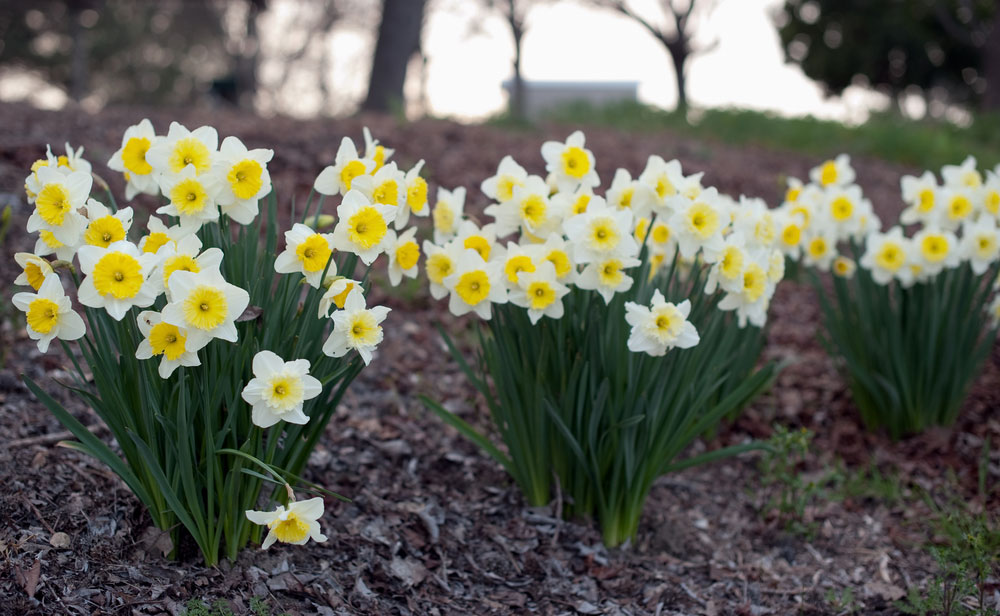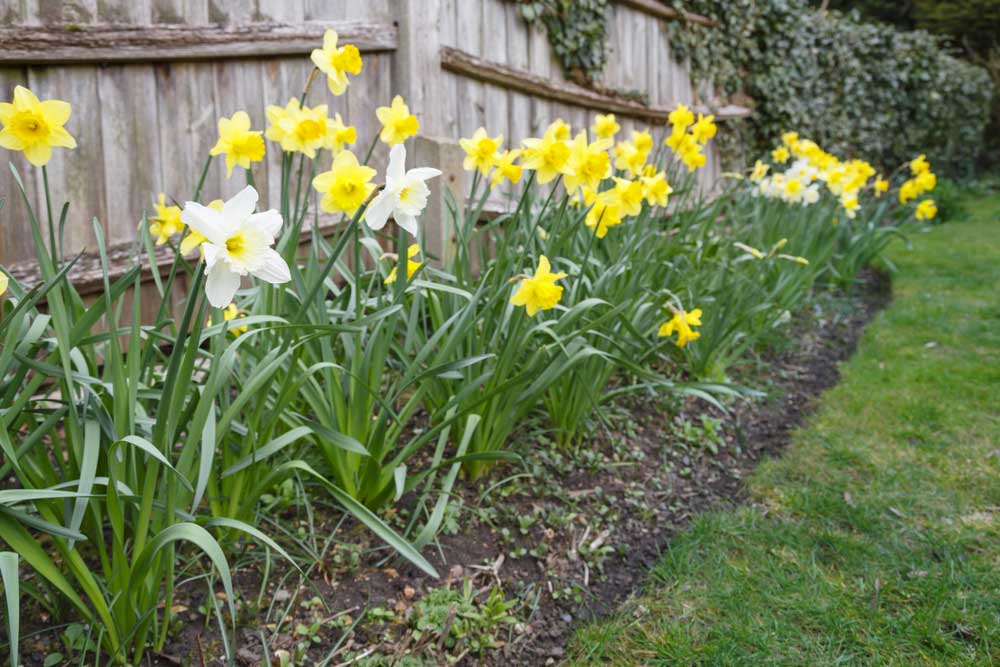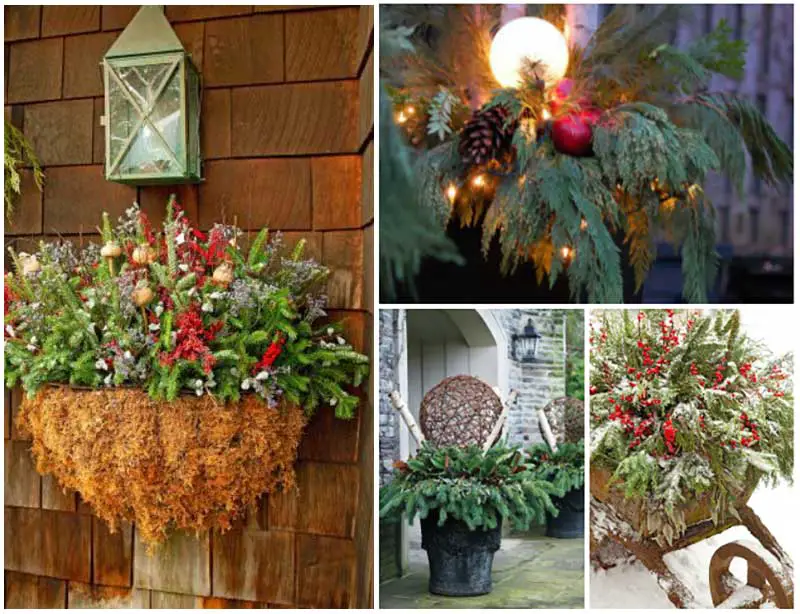
Daffodils announce the arrival of spring with their cheery blooms often before all the snow and ice have melted. These delightful perennial bulbs can be planted in rock gardens, along walkways, or sprinkled through the flowerbed to bring color to the bed long before summer perennials break through the ground.
While the most common color associated with daffodils is yellow, there are daffodils in white, orange, pink, and bicolor too.
By choosing a variety of colors and blooming times, you can have bright colors in your spring garden for a month or more.
| Botanical Name: | narcissus spp |
| Common Name(s): | Daffodils, jonquils, trumpet narcissus |
| Plant Type: | perennials |
| Mature Size: | 6” to 30” |
| Sun Exposure: | Full sun |
| Water Needs: | 1 inch per week |
| Soil Type: | loamy, fertile |
| Soil pH: | 6.0 to 7.0 |
| Bloom Time: | Early to Late Spring |
| Maintenance: | Low |
| Flower Color: | Yellow, white, pink, orange, bicolor |
| Hardiness Zones: | 3-8 |
| Toxicity: | mildly toxic, especially bulbs |
Light
Daffodils need full sun for at least six hours a day to bloom. Although the foliage will grow in less light, the plants will not produce blooms or have a few small ones.
Keep in mind that direct sunlight is vital for good daffodil growth in the spring, but they can be planted in shady areas or partially shady during the summer when deciduous trees leaf out again.
Water
Daffodils prefer partially moist soil, but that isn’t generally an issue in early spring when new growth begins. Because the soil is typically wet from the melting snow and ice in the spring, you won’t likely need to water your daffodils. However, if the soil is dry and you don’t receive an inch of rain weekly, you should water your daffodils deeply once a week.

Temperature & Humidity
Daffodils are perennial bulbs that overwinter in the soil. They sprout and grow on their own in the spring when the time is right, often before all the snow and ice are gone from the garden. However, daffodil bulbs require 10 to 14 weeks of cold weather with soil temperatures between 35- and 45 degrees F to initiate blooming.
This is the reason daffodils can only be grown to zone 8. Warmer zones do not provide the bulbs with the cold period they need to bloom.
Soil
Daffodils need loose, well-draining soil. They prefer loamy or sandy fertile soil with a pH between 6.0 and 7.0. While they will adapt to nearly any soil, clay soil is not recommended as it may hold too much water and cause the bulbs to rot.
If you have clay soil, amend it with copious amounts of compost or well-rotted manure before planting daffodil bulbs. This provides a source of slow-release nutrients, creates air pockets to provide air for the bulbs and roots, and promotes good drainage.
Fertilizer
Although daffodils like fertile soil, they do not need to be fertilized frequently. Applying high phosphorus fertilizer, like bonemeal, when you plant them in the fall and then again each fall is typically enough fertilizer for daffodils.
If you neglect to fertilize them in the fall, give them fertilizer in the spring when the foliage is 1 to 2 inches high.

Are daffodils toxic?
All parts of the daffodil plant are mildly toxic, but the bulbs are of the most concern. Ingesting parts of the daffodil plant can cause vomiting, diarrhea, and abdominal pain. In some cases, it can lead to cardiac or respiratory problems.
However, large amounts of daffodils would need to be consumed to pose a severe health risk. Small children and pets may react more severely. Always seek medical advice if you suspect your children or pets have accidentally ingested parts of the daffodil plant.
Lifting and Dividing
Daffodils tend to spread in the garden after several years. If they become overcrowded, they will cease blooming or produce smaller blooms. Daffodils should be lifted and divided every three to five years.
Dig up your daffodil bulbs any time after the foliage has died back in mid-summer or fall. Separate the bulbs and replant them in similar growing conditions.
Bulbs should be planted to a depth two to three times the bulb’s height, with the bulb’s shoulder resting at this level. Cover the bulbs with soil and firm it down gently with your hands to secure the bulbs in place.
Water the bulbs to saturate the soil and keep it moist for the next three weeks by watering about once a week. This helps the bulbs establish a good root system for supporting next year’s blooms.

Deadheading and Pruning
Old blooms should be removed from your daffodil plant as soon as they fade. You can cut the stem back to the soil level at this time.
But do not cut or prune the foliage. Daffodil foliage performs photosynthesis from the sun’s rays to store energy in the bulb. Cutting the foliage back before it dies will weaken your daffodil bulbs and prevent blooming the following year.
Cut the foliage back after it yellows and dies.
FAQs
How many blooms do you get from one daffodil bulb?
In the first season, you can expect one to three blooms from each daffodil bulb. They will produce more blooms in the following years, often producing six or more blooms from each bulb.
Can you grow daffodils in containers?
Some prefer to grow daffodils, especially miniature daffodils, in window boxes or containers. However, if you choose this option, you will need to plant them in the fall and allow them plenty of time for cold exposure before moving them to an area where the soil in the planter will not freeze.
Can you force daffodils in vases of water in the winter?
Daffodils can be forced into bloom in the winter in a bulb vase, but beware. The bulbs must be chilled for 10 to 14 weeks to initiate blooming. You can buy bulbs in the fall, store them in the refrigerator for three months, and then force them in a bulb vase.




